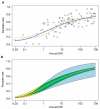The entomological inoculation rate and Plasmodium falciparum infection in African children
- PMID: 16306991
- PMCID: PMC3128496
- DOI: 10.1038/nature04024
The entomological inoculation rate and Plasmodium falciparum infection in African children
Abstract
Malaria is an important cause of global morbidity and mortality. The fact that some people are bitten more often than others has a large effect on the relationship between risk factors and prevalence of vector-borne diseases. Here we develop a mathematical framework that allows us to estimate the heterogeneity of infection rates from the relationship between rates of infectious bites and community prevalence. We apply this framework to a large, published data set that combines malaria measurements from more than 90 communities. We find strong evidence that heterogeneous biting or heterogeneous susceptibility to infection are important and pervasive factors determining the prevalence of infection: 20% of people receive 80% of all infections. We also find that individual infections last about six months on average, per infectious bite, and children who clear infections are not immune to new infections. The results have important implications for public health interventions: the success of malaria control will depend heavily on whether efforts are targeted at those who are most at risk of infection.
Figures

References
-
- Dietz K. Models for vector-borne parasitic diseases. Lecture Notes Biomath. 1980;39:264–277.
-
- Dye C, Hasibeder G. Population dynamics of mosquito-borne disease: effects of flies which bite some people more frequently than others. Trans. Soc. Trop. Med. Hyg. 1986;80:69–77. - PubMed
Publication types
MeSH terms
Grants and funding
LinkOut - more resources
Full Text Sources

